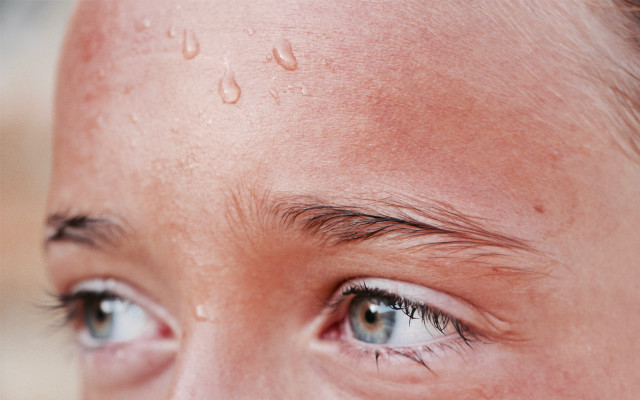
It is hot in almost all of Germany – and people are gradually realizing that this is not just a reason to be happy: heat is a symptom of the climate crisis. It is damaging human health and causing deaths around the world. But how hot is actually too hot for the human body?
People’s perception of temperature varies: some can really enjoy 30 degrees in the shade, others hardly dare to go out. At some point, however, almost every human body will react to heat with dangerous stress symptoms. The answer to the question of how much heat people can actually tolerate is becoming more and more controversial in view of the rising temperatures – and not an easy one for science to answer.
“Heat waves are linked to the climate crisis”
Weather and climate researchers around the world are now certain: Extreme heat is becoming more frequent, longer and hotter. “Heat waves are fundamentally linked to the climate crisis. There is no need to hold back with this statement today,” says meteorologist and ZDF weather presenter Özden Terli in an interview with Utopia.
But the increasing heat is not only causing local droughts, forest fires and water shortages: experts believe that hundreds of thousands of heat-related deaths worldwide each year are already due to the effects of the climate crisis. According to a 2022 study by the RKI, the death rate during heat waves is rising sharply in Germany.

The people who are particularly at risk from heat include older people and people with health problems. Heat is also particularly dangerous for babies, small children, pregnant women and many chronically ill people. But when does it become too hot for average, healthy adults?
“You can’t really draw a clear line,” says weather expert Terli. Temperatures above 35 degrees are often seen by the public as particularly critical. “But even lower temperatures and high humidity can be stressful for the body.”
When does heat become dangerous?
It is not just the heat that is dangerous: research shows that in addition to temperature, humidity is also crucial for how the body reacts to heat. It is hardly possible to calculate a simple threshold value from this, such as “at X degrees it is dangerous”.
The term wet-bulb temperature (also known as cooling limit temperature) keeps cropping up in connection with the effects of heat and humidity. This means “the lowest temperature that can still be reached by direct evaporative cooling,” as the science magazine Spektrum explains. In other words, a certain combination of heat and humidity above which the human body temperature begins to rise because the body can no longer release heat through sweating (= evaporation). This overheating of the body can be life-threatening.
However, the wet bulb temperature was not originally developed for application to human bodies and is a gross simplification. Nevertheless, the values assumed so far are alarming. An experiment indicates that the critical threshold could be lower than assumed: According to a study by scientists at Pennsylvania State University, it is already at an average wet bulb temperature of around 31 degrees Celsius – reached at an outside temperature of 36 to 40 degrees.

Even if the concept is not ideal for describing the effects of heat on humans because it does not take all factors into account, the US researchers formulate an important finding: “A threshold […] cannot be applied to human adaptability for all climatic conditions.”
In other words, heat can always be dangerous. It would be risky to rely on a specific value below which we can feel safe. Instead, we should always be as careful as possible in high temperatures – and especially in humid air – and protect ourselves and others.
ZDF weather expert Terli warns:
“You really have to be careful if you can. If it gets too hot, you have to hold back, especially if it’s humid.”
Why overheating is life-threatening
Because if the so-called “critical ambient limit” is exceeded – that is, the combination of humidity and ambient temperature above which the body can no longer cool itself – then the body’s core temperature rises. The heat builds up in the body if it can no longer dissipate it through sweating.

The heart then works faster and harder to pump blood through the skin so that the body can dissipate the heat. Sweating simultaneously reduces body fluids. Overheating (heat stroke or sunstroke) can quickly become life-threatening.
The “perceived temperature”
The fact that the wet bulb temperature concept used above is extremely simplistic has been criticized by meteorologist Prof. Dr. Andreas Matzarakis from the Center for Medical Meteorological Research at the German Weather Service (DWD), among others. He believes that a combination of psychological surveys and standardized measurements of the most important body parameters makes more sense. Such calculations – combined with values for temperature, humidity and wind conditions – form the basis for the “perceived temperature” used by the DWD and the published heat warnings.
There are also critical thresholds for the “perceived temperature”, but these are variable. “People perceive the temperatures differently at the beginning of the heat season than at the end, so a certain adjustment takes place,” says Matzarakis. At the beginning of summer, the threshold above which heat-related deaths increase is around 32 degrees, and towards the end of summer it rises to over 34 degrees.

However, humidity can increase the “perceived temperature” even at lower outside temperatures. This is because the higher the humidity, the slower the evaporation of sweat from the skin and thus the body’s own cooling. In particular, when the air temperature rises above the average skin temperature of around 33 degrees, it becomes more difficult for the body to cool itself. “People cope with dry heat waves more easily than humid heat waves,” says the meteorologist.
“Temperatures above 35 degrees do not belong in Germany”
Both Terli and Matzerakis predict that as global warming progresses, not only the number of hot days will increase in Germany, but also the number of humid and warm days, i.e. days with high temperatures and high humidity. The risk of heat-related health hazards will therefore increase.
Because: Many experts warn that humans cannot adapt to higher temperatures and humidity levels at the same pace as climate change is driving them. Matzarakis also says:
“Humans’ adaptation to heat is always only partial and limited.”
Özden Terli also points out: “Temperatures significantly above 30 degrees or even above 35 degrees do not really belong in Germany. They are dangerous per se – even in dry air.”
The extreme scenarios of rising humidity levels cannot yet be foreseen. And there are still many uncertainties about the effects of the climate crisis beyond heat and humidity. “We have to be prepared for the fact that we will experience completely different effects.”
Tips for dealing with heat
It’s easy for people who primarily work at a desk to say this, but when temperatures are high, we should all protect ourselves as best as possible, for example by drinking plenty of fluids, avoiding direct sunlight, and reducing physical activity.
By the way: Pets also suffer from high temperatures. You can find out what you should look out for with dogs when it’s hot in the Dos & Don’ts for dogs in summer.
Here are some tips for dealing with heat:
- 5 tips to beat the heat: This is how southern Europeans do it
- Cooling your apartment without air conditioning: tips & tricks
- Sleeping in the heat: 12 common mistakes that make you sleep worse
- Prevent sunburn: 10 tips you should know
- Animals suffer from the heat: How you can help
Read more on Techzle\.com:
- We should stop talking about climate change
- Climate protection: 15 simple tips that everyone can do
- SUV fans and frequent flyers: How to talk to people who don’t care about the climate crisis
** marked with ** or orange underlined Links to sources are partly affiliate links: If you buy here, you are actively supporting Techzle\.com, because we then receive a small part of the sales proceeds. .